Biochem Lec 26- Pyruvate Metabolism 2: Citric Acid Cycle
1/18
There's no tags or description
Looks like no tags are added yet.
Name | Mastery | Learn | Test | Matching | Spaced |
|---|
No study sessions yet.
19 Terms
What step of respiration is the citric acid cycle?
It is the second step.
Where does the citric acid cycle occur in the cell and what does it do?
Occurs in the matrix of the mitochondria
Site of oxidation of acetyl CoA from catabolism of glucose, fatty acid, and amino acid fuels
Produces a lot of reducing power in the form of NADH and FADH2
How is the proton gradient formed?
CAC output: per turn → 3 NADH, 1 FADH₂, 1 GTP(ATP).
ETC uses those electrons:
Complex I (from NADH), III, IV pump H⁺ from matrix → intermembrane space.
Complex II (= succinate dehydrogenase from the CAC) passes electrons from FADH₂ to the ETC but doesn’t pump protons.
Resulting gradient: high [H⁺] (and positive charge) in the intermembrane space, low [H⁺] in the matrix → an electrochemical gradient
What is the significance of acetyl CoA in the citric acid cycle? What is produced?
Acetyl CoA produced by PDH enters the citric acid cycle→ In one turn of the citric acid cycle, acetyl CoA is oxidized releasing free CoA and two CO2
8 electrons of reducing power produced in form of 3 NADH and 1 FADH2
One high energy phosphate GTP (converted to ATP)

What type of reaction is performed in the CAC and what do they do?
CAC includes a series of oxidation-reduction reactions→ oxidation of an acetyl group (2 C) to two molecules of CO2 (2 C total)
2 carbons enter→ 2 oxidized carbons leave (plus high-energy electrons and an ATP equivalent)

Citric Acid Cycle: Step 1
1: Citrate synthase
Oxaloacetate + Acetyl CoA→ Citryl CoA + H2O→ Citrate + CoA
Citrate synthase is the entry point for the cycle→ committed step to CAC
Condensation of acetyl CoA with oxaloacetate to produce citrate
Citrate is a key metabolite→ high levels indicate high citric acid cycle activity and an energy rich state
Highly exergonic because of hydrolysis of intermediate Citryl CoA (cleavage of high energy thioester bond)
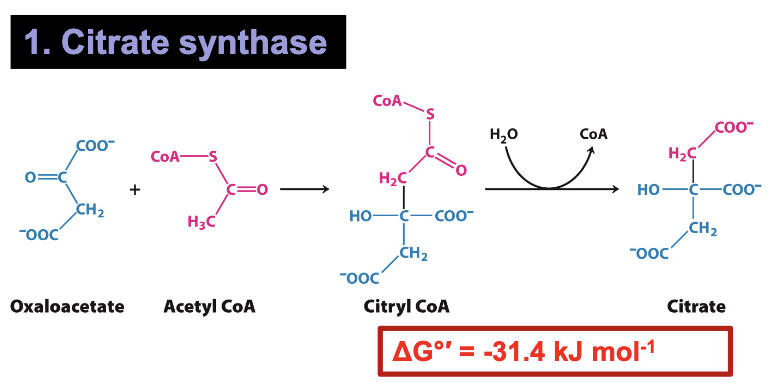
Citric Acid Cycle: Step 2
2: Aconitase
Citrate→ cis-Aconitate + H2O→ Isocitrate
Generation of isocitrate from citrate (isomerization)
Achieved through dehydration followed by hydration
Import for setup of next two oxidative decarboxylation reactions
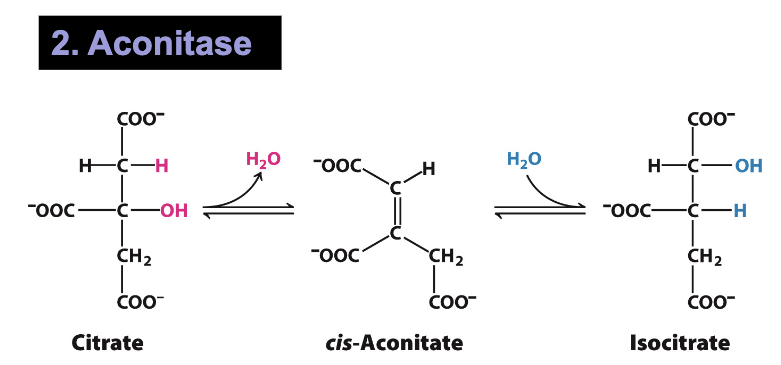
What occurs during steps 3 and 4 of the CAC
Reactions 3 and 4 are critical “oxidative decarboxylation” reactions
This is where two CO2 molecules are lost
Reducing power in the form of 2 NADH are generated
As we will see later, these two enzymes are points of regulation
Citric Acid Cycle: Step 3
3: Isocitrate Dehydrogenase
Isocitrate dehydrogenase oxidizes isocitrate which spontaneously eliminates CO2
The product is a 5 carbon compound known as α-ketoglutarate
NADH is generated
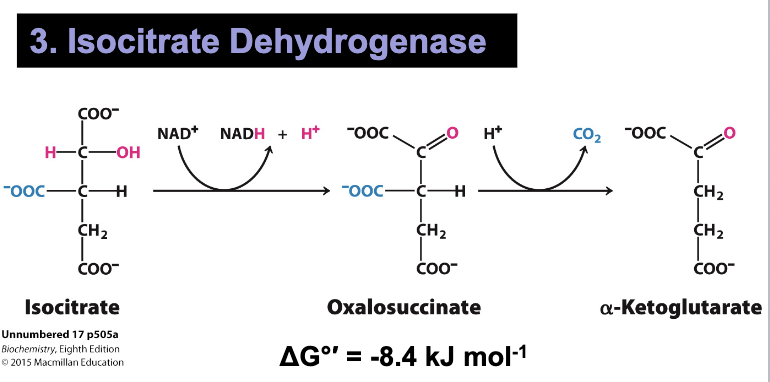
Citric Acid Cycle: Step 4
4: α-Ketoglutarate Dehydrogenase
Very similar mechanism as pyruvate dehydrogenase (contains lipoamide and TPP cofactors)
Oxidative decarboxylation to release second CO2
NADH is generated
Energy is stored on a thioester product→ Succinyl CoA
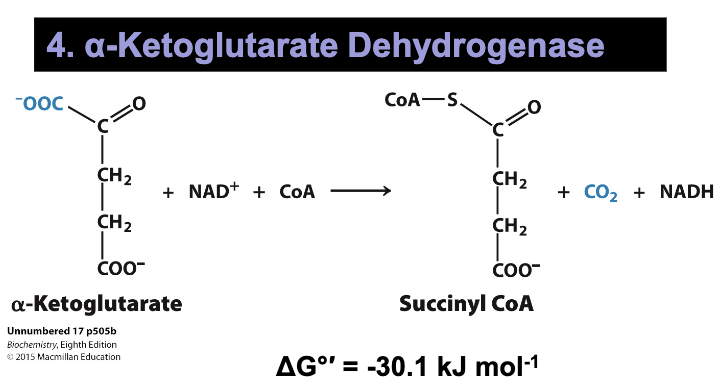
Citric Acid Cycle: Step 5
5: Succinyl CoA Synthetase
Generation of succinyl CoA in the previous reaction allows harvest of a high energy phosphate by Succinyl CoA Synthetase
Cleavage of thioester bond is coupled to the phosphorylation of ADP to yield ATP→ possible because succinyl CoA has higher phosphoryl transfer potential than ATP
Hydrolysis of thioester leads to the production of one molecule of ATP (GTP)→ GTP and ATP is interchangeable by enzyme nucleoside diphosphokinase
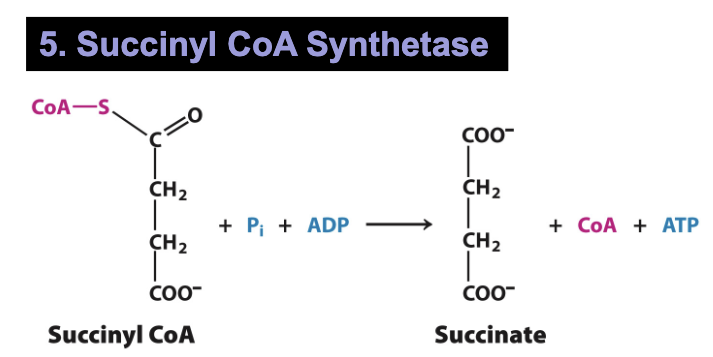
Citric Acid Cycle: Step 6
6: Succinate Dehydrogenase
Conversion of succinate to fumarate (alkane to alkene) harvests 2 additional electrons
Succinate Dehydrogenase is imbedded in the inner mitochondrial membrane and shuttles electrons directly to the Electron Transport Chain
FAD oxidizes succinate→ fumarate and generates FADH2
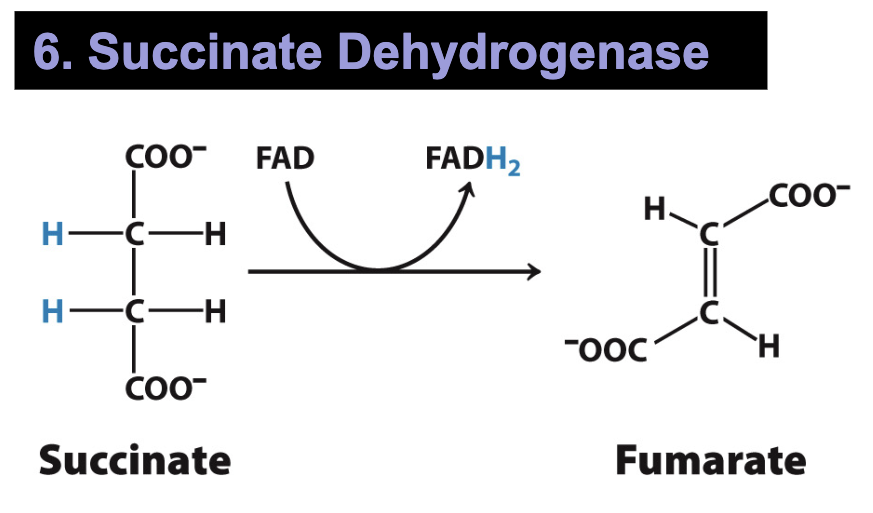
Citric Acid Cycle: Steps 7 and 8
7 and 8: Fumarase and Malate Dehydrogenase
Fumarase and Malate Dehydrogenase complete the cycle with the regeneration of oxaloacetate and the harvest of one last NADH
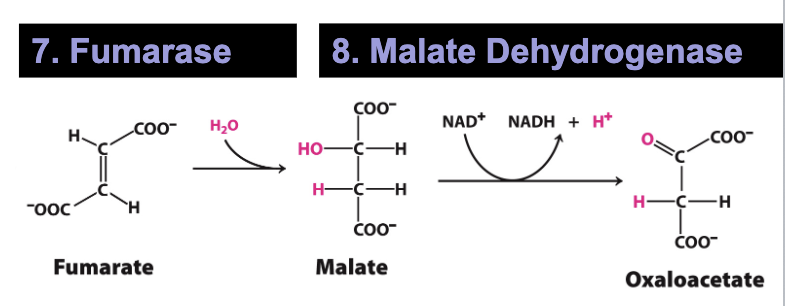
Recap the citric acid cycle, What occurs and what is produced/consumed?
2 carbon atoms in the condensation of an acetyl unit (from acetyl CoA) with oxaloacetate→ 2 carbon atoms leave in form of CO2
Three molecules of NAD+ are reduced to NADH and one molecule of FAD is reduced to FADH2→ yields 8 electrons
One compound with high phosphoryl transfer potential, ATP, is generated from the cleavage of the thioester linkage in succinyl CoA
Two molecules of water are consumed
What is the net reaction of the citric acid cycle?

Briefly, how is the CAC regulated?
Entry of fuel molecules into the CAC is regulated by phosphorylation/dephosphorylation of PDH
Performed by PDH kinase and PDH phosphatase
Phosphorylated=inactive
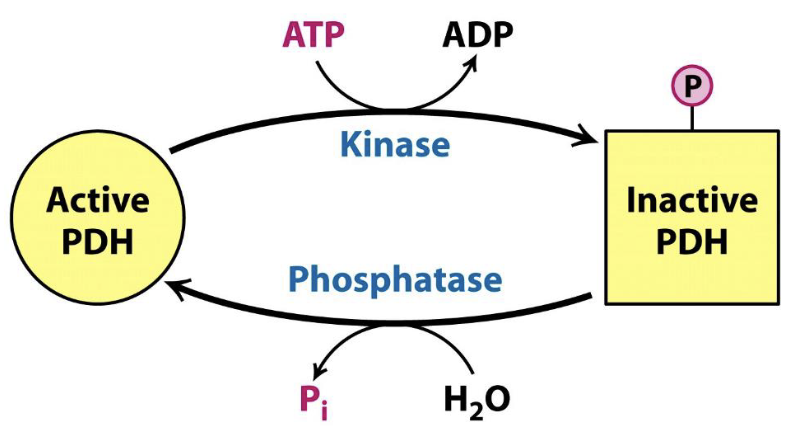
How is PDH kinase activated/inhibited? What is the result of this?
PDH Kinase activated by→ high [NADH], [Acetyl CoA], and [ATP]
PDH Kinase inhibited by→ pyruvate and ADP (phosphatase activity dominates)
Result: PDH is regulated by energy charge
![<p>PDH Kinase activated by→ high [NADH], [Acetyl CoA], and [ATP]</p><p>PDH Kinase inhibited by→ pyruvate and ADP (phosphatase activity dominates)</p><p>Result: PDH is regulated by energy charge</p>](https://knowt-user-attachments.s3.amazonaws.com/9f6b5695-e5a6-4a5c-9e14-eea26b136db3.png)
How is PDH phosphatase activated?
Activated by→ pyruvate and ADP
Can also be activated by Ca2+:
Muscle→ contraction
Liver→ epinephrine signaling
Insulin signaling→ activates phosphatase in liver
What are the two irreversible points of regulation in the CAC?
Two oxidative decarboxylation steps (3 and 4)→ Isocitrate dehydrogenase and α-ketoglutarate dehydrogenase
Inhibited by reducing power (NADH) and ATP
α-ketoglutarate dehydrogenase also inhibited by product (negative feedback)
Stimulated by low energy (ADP)
